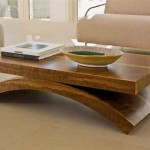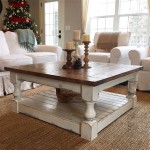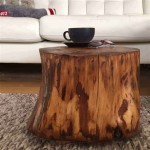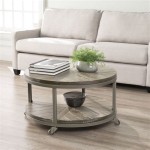```html
Decorating Ideas for Round End Tables
Round end tables, characterized by their smooth, circular surfaces, offer a versatile and aesthetically pleasing addition to any living space. Unlike their square or rectangular counterparts, round end tables possess a softer visual impact, promoting a sense of flow and harmony within a room. Their adaptability extends to various design styles, seamlessly integrating into modern, traditional, or eclectic aesthetics. Maximizing the decorative potential of a round end table requires careful consideration of several factors, including functionality, scale, and the overall ambiance of the room.
The primary function of an end table is to provide a convenient surface for placing essential items within easy reach. This might include lamps, books, beverages, remote controls, or decorative objects. Beyond mere functionality, however, an end table serves as a valuable canvas for expressing personal style and enhancing the visual appeal of the surrounding environment. Effective decorating transforms a utilitarian piece of furniture into a focal point that complements and elevates the overall design scheme.
Achieving Balanced Proportions
One of the most crucial aspects of decorating a round end table is achieving balanced proportions. The size of the table should be commensurate with the size of the furniture it accompanies, such as a sofa or armchair. A table that is too small will appear insignificant and fail to adequately serve its intended purpose. Conversely, a table that is too large will overwhelm the space and disrupt the visual harmony of the room.
Consider the height of the table in relation to the seating it accompanies. Ideally, the surface of the end table should be roughly level with the arm of the adjacent sofa or chair, or slightly higher. This allows for easy access to items placed on the table without requiring excessive reaching or straining. While a slight variance in height can be acceptable, a significant discrepancy will compromise both functionality and aesthetics.
The objects placed on the table should also be scaled appropriately. A large, bulky lamp atop a small, delicate end table will create an imbalanced and visually jarring effect. Opt for accessories that are proportionate to the table's size, ensuring that the arrangement appears cohesive and well-considered. A single statement piece, such as a beautifully crafted vase or a stack of elegantly bound books, can be more effective than an assortment of smaller, unrelated items.
Furthermore, consider the visual weight of the objects placed on the table. Balancing heavier objects with lighter ones can create a more dynamic and engaging display. For example, a substantial lamp base can be counterbalanced by a lightweight decorative bowl or a small stack of paperbacks. This creates a sense of visual equilibrium that is pleasing to the eye.
Creating Visual Interest Through Layering
Layering is a fundamental principle of interior design that can be effectively applied to decorating a round end table. By layering objects of varying heights, textures, and shapes, you can create a visually interesting and dynamic display. This technique adds depth and dimension to the arrangement, preventing it from appearing flat or monotonous.
Begin with a foundation piece, such as a tray or a decorative book. This provides a stable base for layering other objects and helps to define the arrangement. The tray can be made of various materials, such as wood, metal, or ceramic, depending on the desired aesthetic. A decorative book can add a touch of sophistication and intellectual appeal.
Next, add a taller element, such as a lamp, a vase of flowers, or a sculptural object. This provides verticality and draws the eye upward, creating a sense of balance and proportion. The height of this element should be carefully considered to ensure that it is proportionate to the size of the table and the surrounding furniture.
Finally, incorporate smaller accent pieces, such as candles, coasters, or decorative bowls. These add visual interest and personality to the arrangement. Consider using objects of varying textures and materials to create a more tactile and engaging display. For example, a smooth ceramic bowl can be paired with a rough-hewn wooden coaster.
When layering objects, be mindful of negative space. Avoid overcrowding the table with too many items, as this can create a cluttered and overwhelming effect. Allow for some breathing room between objects to allow each piece to be appreciated individually. The goal is to create a harmonious and balanced arrangement that is both visually appealing and functional.
Incorporating Elements of Functionality
While aesthetics are important, the primary function of an end table should not be overlooked. The objects placed on the table should be both decorative and functional, serving a practical purpose in addition to enhancing the visual appeal of the room. This approach ensures that the end table is not merely a decorative accessory but also a useful and convenient addition to the living space.
A lamp is a classic and essential element for any end table. Choose a lamp that provides adequate lighting for reading or other activities. The style of the lamp should complement the overall design aesthetic of the room. Consider the size and shape of the lampshade to ensure that it is proportionate to the table and the surrounding furniture. A dimmable lamp offers added flexibility allowing adjustment of the light level according to need or mood.
A coaster is another essential item for protecting the surface of the end table from water rings and spills. Choose coasters that are both functional and aesthetically pleasing. Coasters made of materials such as stone, leather, or wood can add a touch of sophistication to the arrangement. Consider using a coaster holder to keep the coasters organized and readily accessible.
A storage element, such as a decorative box or a small basket, can be a useful addition to an end table. This provides a convenient place to store small items, such as remote controls, reading glasses, or charging cables. Choose a storage element that complements the overall design aesthetic of the room. A decorative box made of wood, metal, or fabric can add a touch of elegance to the arrangement.
Books are a classic and versatile element for decorating an end table. A stack of beautifully bound books can add a touch of sophistication and intellectual appeal to the room. Choose books that are relevant to your interests or hobbies. Consider using bookends to keep the books organized and upright. A small, decorative bookmark can add a personal touch.
By incorporating elements of functionality into the design, the end table becomes a more valuable and useful piece of furniture. This approach ensures that the end table is not merely a decorative accessory but also a practical and convenient addition to the living space. Balancing aesthetics with functionality is key to creating a well-designed and harmonious arrangement.
Ultimately, the best way to decorate a round end table is to experiment with different arrangements and find what works best for your personal style and the overall aesthetic of your room. Consider the size and shape of the table, the surrounding furniture, and the desired level of functionality. By carefully considering these factors and incorporating the principles of balance, layering, and functionality, you can create a visually appealing and practical display that enhances the beauty and comfort of your living space.
```
Style A Round Coffee The Easy Way Stonegable

Diy Round Side Table Makeover My Creative Days

Round Distressed Metal Side Table Antique Farmhouse

How To Pick Decorate The Right End Table

How To Style A Round Coffee Table Decor Fix

Ten Decorating Ideas For Round Coffee Tables

Round Corner Table Decor

Coffee Table Decor Ideas And Trends For 2025

Spring Coffee Table Decor Ideas That Work All Year Round Farmhousehub

The Basics Of Coffee Table Styling Shades Blue Interiors
Related Posts








